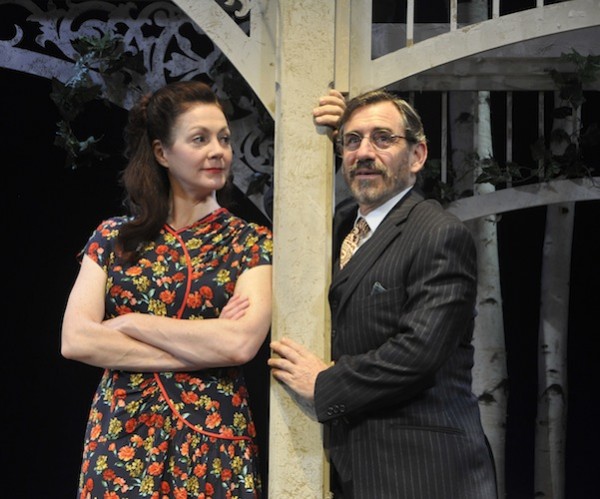Theater Review: Peterborough Player’s “Talley’s Folly” — Embraceable Jew
The pleasure of Talley’s Folly is in its details, the give-and-take of the dialogue, the smaller and larger revelations they tease out of each other, the characterization of the two human creatures dancing their dance.
Talley’s Folly by Lanford Wilson. Directed by Gus Kaikkonen. Staged by the Peterborough Players, Peterborough, New Hampshire, through September 15.
By Jim Kates

David Breitbarth and Kate Hampton kicking up their heels in TALLEY’S FOLLY at the Peterborough Players. Photo: Deb Porter-Hayes.
Watching Lanford Wilson’s Talley’s Folly is a little like watching a ninety-minute television nature film of mating rituals in the animal world. Two human creatures, male and female, display and retreat, feathers get ruffled, hackles raised, a little fur flies, and the end is satisfactorily predictable. That’s the nature of romantic comedy.
In this case, the male in full three-piece plumage is Matt Friedman, an accountant from St. Louis who talks, in David Breitbarth’s embodiment, as if his natural habitat were Damon Runyon’s Broadway, and Sally Talley, a Missouri girl restless to escape the nest, played by Kate Hampton. The character is carefully protective of her shell, to use a metaphor straight from the script. The folly of the title is the setting, a gingerbread riverside boathouse bathed in moonlight, wondrously detailed by the scenic designer Charles Morgan, and all of it gracefully used under the direction of Gus Kaikkonen.
The lavishness of the set is balanced by the frugality of the cast — the boy and the girl act out their courtship all on their own — this whole beautifully crafted world has been designed for them alone. They bring to it worlds that have been less generous and less hospitable, Friedman a wandering Jew who has lost his family to the politics of the twentieth century, Talley a hometown girl who has disappointed the complacent expectations of her Midwestern society. They each bring a special kind of bitterness that somehow, by a strange alchemy, turns into golden sweetness at the end.
The setting behind the setting of Talley’s Folly is a world at war in 1944, a constant counterpoint to the private engagement of the play. But not too much is made of this, it’s just where and when they are, just as nothing much is made of the possible pun on “folly.” Talley has been a victim, and she maintains an alert wariness, but she evinces no foolishness — only convincing mystery. Hampton keeps her character’s guard up with absolute authority, and with a warmth that makes her letting it down at the end credible.
Breitbarth’s portrayal of Friedman is a little more problematic. On the one hand, lines he is given to say are far more nebbishy than the confident way he presents them to us; on the other hand, he draws throughout on Jewish stereotypes of mannerism that border on caricature — as if he were playing not a real Jewish man from St. Louis, but a Jew as might be imagined by a rural Missouri Protestant in the 1940s. Breitbarth manages to keep on the fair side of offense, but he does come dangerously close.

David Breitbarth and Kate Hampton in TALLEY’S FOLLY at the Peterborough Players. Photo: Deb Porter-Hayes.
In his long opening monologue that draws attention to the artificiality of the theater (a theme that has run through the Peterborough Players’ productions this season), Friedman calls the play we are about to see a valentine, and specifies (referring explicitly to the boathouse folly) that valentines need frou-frou. For all its touching on dark or heavy elements of the time, from anti-Semitism to the Great Depression, the Second World War expectations of women’s roles, Talley’s Folly never gets far beyond the frou-frou. The action takes place on the evening of July 4, but that’s been an ordinary working Tuesday for Talley. it doesn’t seem to mean much more than distant bandstand music, unless we’re expected to understand Sally as achieving a kind of independence at the end. Even the successful consummation of the mating ritual, we learn in the last moments, will not contribute to the continuation of the species.
Wilson claimed that the intended subtext of his projected (but not completed) cycle of plays about the Talley family was war and the economics of war. This is reminiscent of how Jane Austen used her own contemporary manners to write about the hard realities of war and economy in early nineteeenth-century society. Wilson does not convey such urgency or depth as Austen commands. The pleasure of Talley’s Folly is in its details, the give-and-take of the dialogue, the smaller and larger revelations they tease out of each other, the characterization of the two human creatures dancing their dance — Friedman himself accurately characterizes it as a waltz (not a tango!) — and coming together.
Jim Kates is a poet, feature journalist and reviewer, literary translator and the president and co-director of Zephyr Press, a non-profit press that focuses on contemporary works in translation from Russia, Eastern Europe and Asia.
